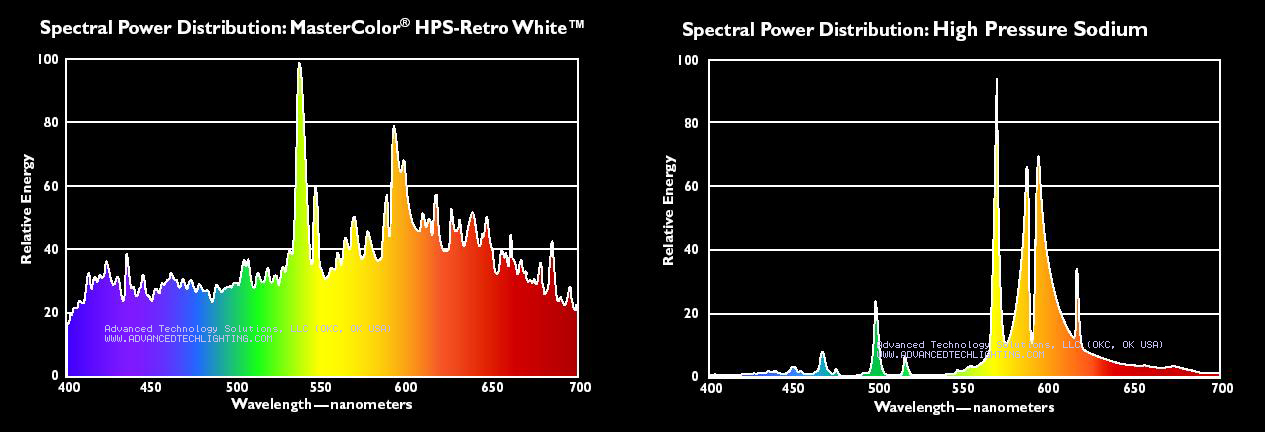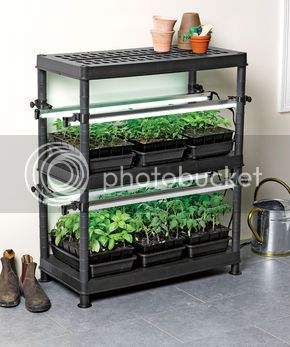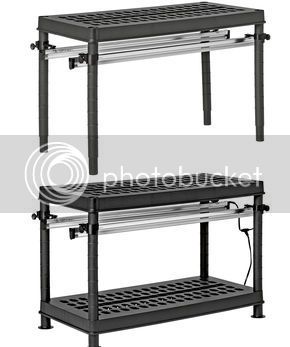Hmm... Interesting! I want to try growing indoors next year. I have a room that gets a lot of sun during the day, but I believe I'll need to supplement it a bit. I have two sunlamps leftover from my time as a frog/beardie mom - if I got new bulbs for these, would they work for indoor growing?
-
Do you need help identifying a 🌶️?
Is your plant suffering from an unknown issue? 🤧
Then ask in Identification and Diagnosis. -
✅ Expert and friendly hot pepper grow advice.
✅ The latest information on hot pepper varieties.
✅ Reliable seed trading.
✅ Hot sauce recipes and food safety guidance.
✅ Hot sauce business tips for startups.
🌶️ And more!
It's all here, at The Hot Pepper! The Internet's original hot pepper community! Est. 2004.
You are using an out of date browser. It may not display this or other websites correctly.
You should upgrade or use an alternative browser.
You should upgrade or use an alternative browser.
indoor-growing [ARTICLE] Light 101
- Thread starter Omri
- Start date
yes, you can just stick a higher power cool white or daylight CFL bulb in them and they work good.Roo said:Hmm... Interesting! I want to try growing indoors next year. I have a room that gets a lot of sun during the day, but I believe I'll need to supplement it a bit. I have two sunlamps leftover from my time as a frog/beardie mom - if I got new bulbs for these, would they work for indoor growing?
(like this eh?)

lumens work just fine as long as you are comparing with white light. So in your case where your using kelvin scale with flouros you are right.AlabamaJack said:OK...if I'm wrong, so be it...
my method has worked for me and that's what counts...
I have said time and time again, what works for me may not work for you...
my simple mind uses lumens as an indicator of how much light the plant will get based on the kelvin spectrum...
and if I am wrong, please tell me and I will stop advising people...
lumens doesn't work once you start using LEDs which produce only a single wavelength (most common red and blue). Manufactures put lumens # on these but it's not a good indicator of how much energy the plant it getting.
Replying to an old post as I am just reading this thread:defeyter said:I am familiar with K levels for CFL (6500K for veg and 2700K for flower). I am thinking of going to a 400w HPS, and I am wondering what kind of bulb I need, as I see different Kelvin notations on those.
- What K HPS bulb would I need for vegging
- What K HPS bulb would I need for flowering?
--- Or do I need just one bulb?
I am currently running about 20,000 lumens with my 4ft 4 bulb T5HO, but I have been told that is not enough lumens for producing peppers.
I am sorry if this question has been answered elsewhere, I just could not find the answer!
Last year, I was able to get peppers with 25,000 lumens (5 T-5 bulbs @ 6,400 K) but not a lot. Now for my new indoor grow, I have 4 T-5s and 20,000 lumens, but am about to add 6 2,800 CFLs, so I'll have 36,800 in total (+ another 5,000 if I can figure out how to add my single bulb T-5 into the mix. The new CFLs are 2,700 K, so maybe will help with pod production. Last year I had NO PROBLEMS getting tons of flowers, just not a lot of pollen and tons fell off.
I've grown peppers under 600w HPS/MH and I have never had an issue with pod production but 600w HPS == 90000 lumens I grow in light sealed environments so all lighting is supplemented no natural lighting.
busamadman said:There actually is a magic bullet, we just can't buy it. The Sulfur Bulb. Developed by a small company in Rockville, MD, it uses a magnetron (like a microwave emitter in your kitchen, not a Hasbro Transformer) that hits a sealed sphere filled with sulfur vapor under a vacuum. There is no socket and the 'bulb' is about the size of a golf ball. To keep it cool, since it is a 5,000 Watt bulb, it sits spinning on a stream of compressed air. (Neat-O!) Later ones used a glass rod attached to the bulb that spins which was less trouble-prone. The big point on these bulbs is that they are VERY close in spectrum to our Sun around 10-11 am in the morning.
The Air & Space museum in DC used two of these to power a light pipe that illuminated their huge front room. I don't know why these disappeared from the marketplace. They are probably not cheap, but (1) 5,000 W sulfur bulb does the work of about (20) 1,000 W HPS lamps.
Here's more on the sulfur bulb:
http://www.kbmorgan....hbull/bull6.htm
Genius DIY'er:
[media]http://www.youtube.com/watch?v=okku7DiS9p4&feature=related[/media]
On sale! But maybe not for the average consumer.
http://www.plasmabright.com/pse1012a.asp
juanitos said:
lumens work just fine as long as you are comparing with white light. So in your case where your using kelvin scale with flouros you are right.
lumens doesn't work once you start using LEDs which produce only a single wavelength (most common red and blue). Manufactures put lumens # on these but it's not a good indicator of how much energy the plant it getting.
Lumens arent a good indicator of anything but how much light is useable to the human eye.
I like to look right at the spectrum that manufacturers usually put out. Sometimes that's hard to find or not available at all.
Example: (this is actually two of them side by side)

Then I check the CRI (color rendering index) that measures how close a light is to rendering the same colors as the sun. I think its a scale of 1 to 100 with 100 being exactly like the sun. If a bulb can come close to rending colors the same as the sun I figure its got a good spectral mix.
That's a 90 CRI bulb on the left on the left and a <65 CRI bulb on the right.
Then watts. Watts will give you a relative power to compare with other bulbs. With LEDs you will usually find a 'luminous flux' value in watts or milliwatts. This tells you exactly how much electricity is being turned into light.
GE has a page with the SPD graphs of their lighting lineup:
http://www.gelighting.com/na/business_lighting/spectral_power_distribution_curves/
http://www.gelighting.com/na/business_lighting/spectral_power_distribution_curves/
I've played with sulphur plasma's lighting it's overhyped and overpriced LED's will be the future of grow lighting but NOT YET and HPS/MH are the best lights available now at any price and they happen to be one of the cheapest.
If you can source and use a 3 phase 415v ballast it will kick the ass in efficiency vs any of the new techs today right now using old technology.
I do have 3 phase but no compatible ballasts (Yet).
I get my test equipment for free benefits of manufacturing plant pots
You guys would drool over the stuff I get given to try for free although I've had to buy my LED's (Which is very telling that they are unwilling to give me a set)
If you can source and use a 3 phase 415v ballast it will kick the ass in efficiency vs any of the new techs today right now using old technology.
I do have 3 phase but no compatible ballasts (Yet).
I get my test equipment for free benefits of manufacturing plant pots
You guys would drool over the stuff I get given to try for free although I've had to buy my LED's (Which is very telling that they are unwilling to give me a set)
Lumens is a very accurate way of comparing same types of lights but different wattages together but they're unsuitable to compare different types of light together.meinchoh said:Lumens are for reading. Incandescent bulbs are measured in lumens and you wouldn't grow much with them.....
HPS are measured in lumens and I know I can take more from HPS watt for watt than any other kind of lighting on the market today.
No you misunderstood what I said Lumens is useful to measure the difference in intesity between the SAME types of light they are useful to compare 250w HPS to 600w HPS but they are not useful to comparing LED's to HPS or sulphur plasma.meinchoh said:Your post doesn't even mention the word "grow".....You're missing my point.
Look BEYOND lumens....
There is no measure for grow lighting that is accurate just hype, lumens are meaningless it's pefectly possible to make an ultra high lumen output LED with almost 0 growing potential. Just like it's possible to make high output PAR lights that are crap for growing flowering plants (But great for vegetative growth) they do it now and call them LED's.
PAR is also missing massive parts of spectrum that is needed and specifically is only the photosynthetic response that is cartered for.
Phytochromes, Cytochromes & other hormonal responses need specific light triggers that are missing in the PAR graph, UVb (~315nm) is also good is small amounts.
Sulphur plasma, LEP, HPS, MH and fluro make a much wider spectrum so this is not an issue but LED's are far more tuned and are lagging behind the others because of it.
As more LED spectrum are added, dimmable multichip led's become the norm so we can dynamically change the wavelengths on the fly then this will all change and led will become the grow light of choice.
There is no ideal grow light for every type of plant the grow light will depend very much on what you are growing to get the best possible light and spectrums this is evidenced by massive salad farms powered by led's growing green leafs BUT almost 0 tomato and cucumber production under led vs HPS commercially.
I didn't realise I had to clarify I was talking about grow lighting in a grow light thread.
Look beyond PAR......
Saw some interesting LED panels earlier in the month with a phosphor coated envelope over the diode.
They're coming along at a rapid pace but still far behind a good 600w and leagues behind the double-enders. Chinese knock-offs flooding the market isn't helping, nor the snake oil advertising used by almost every company to date. Poor canopy uniformity is a major drawback.
There are a few greenhouses I've seen using LED strip lighting, but if I were to gamble, I would say they were given them.
And of course, the biggest draw back, there are almost zero vertical options
Blabbity blah blah blah. Who's this guy talking to, you ask? Himself.
They're coming along at a rapid pace but still far behind a good 600w and leagues behind the double-enders. Chinese knock-offs flooding the market isn't helping, nor the snake oil advertising used by almost every company to date. Poor canopy uniformity is a major drawback.
There are a few greenhouses I've seen using LED strip lighting, but if I were to gamble, I would say they were given them.
And of course, the biggest draw back, there are almost zero vertical options
Blabbity blah blah blah. Who's this guy talking to, you ask? Himself.
miguelovic said:Saw some interesting LED panels earlier in the month with a phosphor coated envelope over the diode.
Were they in the antique section?
able eye said:
Were they in the antique section?
So, in other words, you've got nothing to contribute but wanted to troll around?
miguelovic said:
So, in other words, you've got nothing to contribute but wanted to troll around?
No this is how they first made white diodes.
So its a question.
Maybe what you thought was interesting I just thought was old.
How much were you contributing with your "interesting" stone age technology or did you wanna take that question back now?


